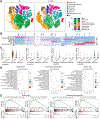IL-22 resolves MASLD via enterocyte STAT3 restoration of diet-perturbed intestinal homeostasis
- PMID: 39317186
- PMCID: PMC11631175
- DOI: 10.1016/j.cmet.2024.08.012
IL-22 resolves MASLD via enterocyte STAT3 restoration of diet-perturbed intestinal homeostasis
Abstract
The exponential rise in metabolic dysfunction-associated steatotic liver disease (MASLD) parallels the ever-increasing consumption of energy-dense diets, underscoring the need for effective MASLD-resolving drugs. MASLD pathogenesis is linked to obesity, diabetes, "gut-liver axis" alterations, and defective interleukin-22 (IL-22) signaling. Although barrier-protective IL-22 blunts diet-induced metabolic alterations, inhibits lipid intake, and reverses microbial dysbiosis, obesogenic diets rapidly suppress its production by small intestine-localized innate lymphocytes. This results in STAT3 inhibition in intestinal epithelial cells (IECs) and expansion of the absorptive enterocyte compartment. These MASLD-sustaining aberrations were reversed by administration of recombinant IL-22, which resolved hepatosteatosis, inflammation, fibrosis, and insulin resistance. Exogenous IL-22 exerted its therapeutic effects through its IEC receptor, rather than hepatocytes, activating STAT3 and inhibiting WNT-β-catenin signaling to shrink the absorptive enterocyte compartment. By reversing diet-reinforced macronutrient absorption, the main source of liver lipids, IL-22 signaling restoration represents a potentially effective interception of dietary obesity and MASLD.
Keywords: IL-22; MASLD; STAT3; WNT-β-catenin; hepatosteatosis; lipid absorption.
Published by Elsevier Inc.
Conflict of interest statement
Declaration of interests M.K. was a founder and stockholder in Elgia Pharmaceuticals and had received research support from Merck and Janssen Pharmaceuticals. P.C.D. consulted for DSM animal health in 2023; is an advisor and holds equity in Cybele, bileOmix, and Sirenas; and is a scientific co-founder and advisor and holds equity in Ometa, Enveda, and Arome, with prior approval by UC San Diego.
Figures







References
MeSH terms
Substances
Grants and funding
LinkOut - more resources
Full Text Sources
Molecular Biology Databases
Miscellaneous

